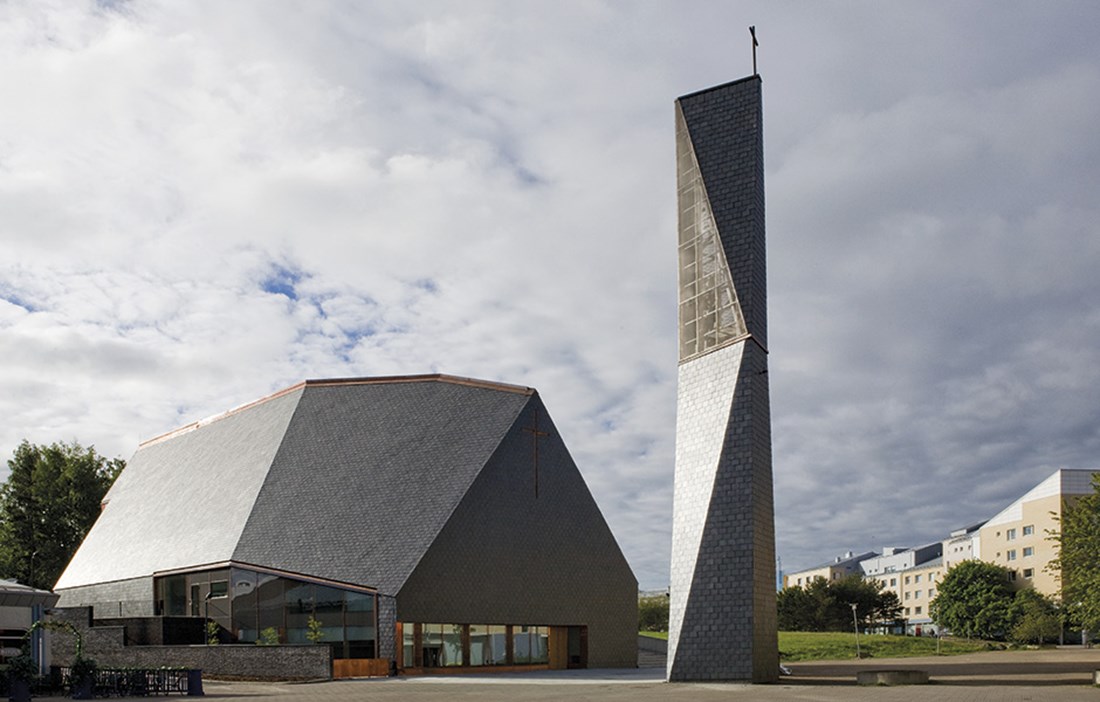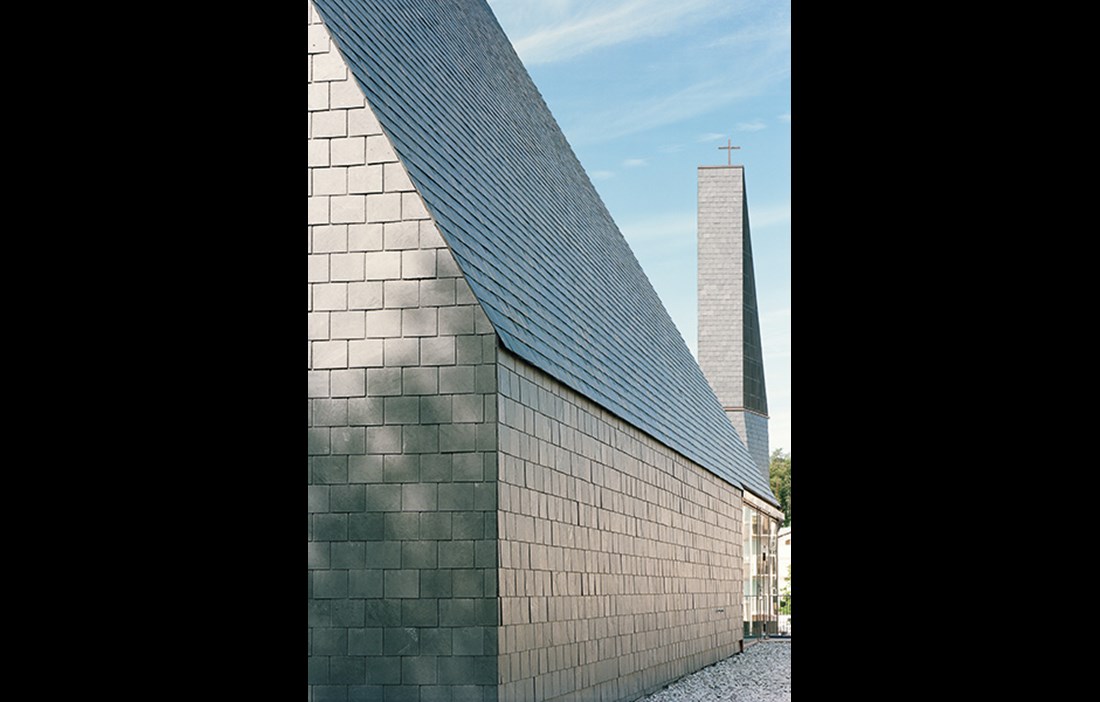THE EXTERIOR IS deceptive. From the outside the church looks like a giant, black, ground stone that someone has just dropped on the square in Kuokkala. The district of Kuokkala is located in Jyväskylä, Finland’s sixth largest city. The church is a sculptural building whose design language can be interpreted in different ways, depending on which direction you approach it from. There is a kinship with the stone churches of the Middle Ages, but with a refined, modern finish. However, the interior comes as a surprise. The dark, angled shape of the outer hull gives way to light, curved shapes made entirely in wood. The church is enchanting, and if the exterior has echoes of a medieval stone church, inside it feels more like a Gothic cathedral with its emphasis on verticals, rib vaulting and pointed arches. The eye is drawn upwards to meet the light that, like a bubbling brook, flows in through the rooflight and filters its way through the wooden decoration behind the altar. The fact that the building is sometimes called Dr Jekyll & Mr Hyde is entirely understandable, although architect Teemu Hirvilammi feels that is not a fair description.
“We always want to make things simple for ourselves as people. We like to see our existence as black or white, hard or soft. Perhaps we feel unable to see a thing of beauty if there’s not something ugly as a contrast. Of course we’ve tried to come up with contrasts, but for the most part we’ve worked to create harmony in what we do. For us, it has been important to give the interior a completely different ambience to the exterior. In this context, the use of wood seemed like an obvious contrast to introduce,” says Teemu Hirvilammi.
“Wood epitomises sustainability and is associated with warmth and humanity. It creates a homely atmosphere and makes a calm and harmonious impression. The stone exterior has other qualities. It’s a solid, comforting material, and just like wood, it represents durability.”
ANSSI LASSILA AND TEEMU HIRVILAMMI were invited to take part in the architectural competition that the parish of Jyväskylä announced in 2006 to build a new church. The competition became a milestone in the parish’s more than 20 year-long struggle to get a church in this new part of the city. High on the wish list was a church that would look like a church. A church ‘at the heart of the village’ with multifunctional features. In addition to the place of worship itself, the building was required to accommodate a range of different activities, including film screenings, music in various guises, a youth centre, assembly rooms and offices. Lassila and Hirvilammi’s proposal ‘Kristalli’ won the competition, making this their third church after the one in the town of Klaukkala and the much admired shingle church in Kärsämäki.
“Of course, we design much more than just churches, but what’s exciting about this kind of building is that it offers great opportunities to create new architecture and make a lasting impression. This is a unique area, because it gives us a chance to work with the most fundamental elements of architecture such as space, light, structure and geometry.”
Kuokkala church is a largely wooden structure, although it does have some steel and concrete components. The church has no conventional walls. The shape is dictated by 13 lime wood arches and a gridshell construction that together form the supporting frame for the roof. The whole wooden construction is anchored using steel plates fixed to a concrete slab. Wood was an obvious choice, because it offers unique scope to achieve an attractive, exciting and harmonious design. An additional benefit is the fact that it is such an eco-friendly, sustainable and natural raw material. The spruce that has been used throughout comes from the forests in and around Jyväskylä.
“The spruce that grows locally is of very high quality. We sawed it radially, perpendicular to the growth rings, which makes best use of the wood’s properties. This method gives a straight-grain timber that holds its shape, is hard and won’t split. We then treated the surface with a white pigmented oil. The church pews, the pulpit and the altar rails are made of ash wood, while the altar and the rest of the decorative features are in lime wood. This is a soft material that is easy to work and is traditionally used for wood carving.”
The different functions of the church are spread across three levels, with the offices at street level, facing directly onto the square. The lower level houses the parish’s assembly rooms and adjoining youth centre. A gallery acts as a link between the church and the assembly rooms. On the top floor lies the organ loft and the musical director’s office. The church is a popular venue for a range of musical events, since its volume and wooden interior help create excellent acoustics.
“One of the challenges was to combine several very different functions in the same building. We achieved this by splitting the building up into three floors and creating flexibility and openness between the levels and the different rooms,” explains Teemu Hirvilammi.
THE DESIGNERS MADE EXTENSIVE USE of Tekla Structures. This is a BIM (Building Information Modelling) program that is used to create and manipulate highly detailed and functional 3D building models for all materials and all degrees of structural complexity. The model has been used for the whole design process, from establishing the concept to manufacture, assembly and building management. The structure is built up in two layers, with the various technical functions placed between the inner and outer shell. The inner gridshell structure is assembled in three different sections.
Externally, both the facade and the roof are clad in black slates that have been overlapped in three layers to form a compact and impervious exterior. The material originates from the Pyrenees, where it was cut down into the right shape. Spanish stonemasons were employed on site for several weeks to work on the exterior, which also has details in copper and wood around the window and entrance sections. Right next to the church itself stands a separate 25 metre bell tower, also a sculptural form underpinned by a concrete and steel structure. The tower holds 23 bells of different sizes from the Dutch foundry Petit-Fritsenin, which has been manufacturing church bells since the 17th century.
The neighbouring square draws the church into the wider cityscape and fulfils the parish’s desire to act as a meeting place for local residents. The wide granite steps that lead up to the entrance act like an outstretched hand, showing the way and drawing visitors into the church.
When I ask Teemu what he is most proud of about the church in Kuokkala, he hesitates.
“The fact that everything works so well together. The building feels complete and nothing can either be added or removed. I’m also proud of the superb collaboration among everyone involved. From the highly ambitious and interested client to us architects and the other consultants, to all the brilliant craftsmen who worked on site.”
Teemu relates that he has a very special relationship with Alvar Aalto. A relationship that has grown strongly thanks to him spending a lot of time in Aalto’s buildings, including the library and church in Säinäjoki. My final question, about what he thinks the Finnish national architect would have thought about the wooden church in Kuokkala, makes him burst out laughing.
“Honestly, I have no idea!”
What is certain is that Jyväskylä now has more than Aalto’s many buildings to attract fans of superb architecture.
Text Katarina Brandt























